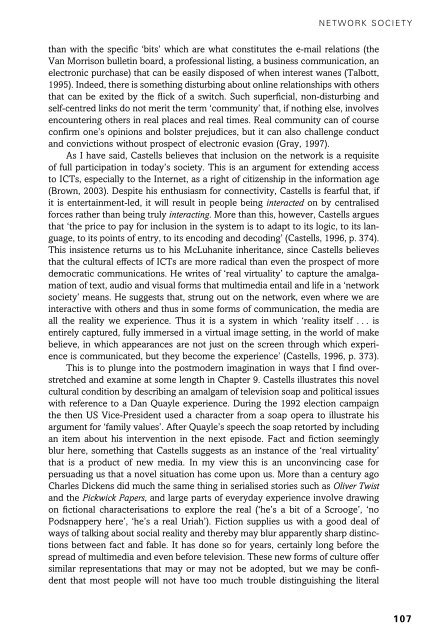Theories of the Information Society, Third Edition - Cryptome
Theories of the Information Society, Third Edition - Cryptome
Theories of the Information Society, Third Edition - Cryptome
Create successful ePaper yourself
Turn your PDF publications into a flip-book with our unique Google optimized e-Paper software.
NETWORK SOCIETY<br />
1<br />
1<br />
1<br />
2<br />
1<br />
1<br />
than with <strong>the</strong> specific ‘bits’ which are what constitutes <strong>the</strong> e-mail relations (<strong>the</strong><br />
Van Morrison bulletin board, a pr<strong>of</strong>essional listing, a business communication, an<br />
electronic purchase) that can be easily disposed <strong>of</strong> when interest wanes (Talbott,<br />
1995). Indeed, <strong>the</strong>re is something disturbing about online relationships with o<strong>the</strong>rs<br />
that can be exited by <strong>the</strong> flick <strong>of</strong> a switch. Such superficial, non-disturbing and<br />
self-centred links do not merit <strong>the</strong> term ‘community’ that, if nothing else, involves<br />
encountering o<strong>the</strong>rs in real places and real times. Real community can <strong>of</strong> course<br />
confirm one’s opinions and bolster prejudices, but it can also challenge conduct<br />
and convictions without prospect <strong>of</strong> electronic evasion (Gray, 1997).<br />
As I have said, Castells believes that inclusion on <strong>the</strong> network is a requisite<br />
<strong>of</strong> full participation in today’s society. This is an argument for extending access<br />
to ICTs, especially to <strong>the</strong> Internet, as a right <strong>of</strong> citizenship in <strong>the</strong> information age<br />
(Brown, 2003). Despite his enthusiasm for connectivity, Castells is fearful that, if<br />
it is entertainment-led, it will result in people being interacted on by centralised<br />
forces ra<strong>the</strong>r than being truly interacting. More than this, however, Castells argues<br />
that ‘<strong>the</strong> price to pay for inclusion in <strong>the</strong> system is to adapt to its logic, to its language,<br />
to its points <strong>of</strong> entry, to its encoding and decoding’ (Castells, 1996, p. 374).<br />
This insistence returns us to his McLuhanite inheritance, since Castells believes<br />
that <strong>the</strong> cultural effects <strong>of</strong> ICTs are more radical than even <strong>the</strong> prospect <strong>of</strong> more<br />
democratic communications. He writes <strong>of</strong> ‘real virtuality’ to capture <strong>the</strong> amalgamation<br />
<strong>of</strong> text, audio and visual forms that multimedia entail and life in a ‘network<br />
society’ means. He suggests that, strung out on <strong>the</strong> network, even where we are<br />
interactive with o<strong>the</strong>rs and thus in some forms <strong>of</strong> communication, <strong>the</strong> media are<br />
all <strong>the</strong> reality we experience. Thus it is a system in which ‘reality itself . . . is<br />
entirely captured, fully immersed in a virtual image setting, in <strong>the</strong> world <strong>of</strong> make<br />
believe, in which appearances are not just on <strong>the</strong> screen through which experience<br />
is communicated, but <strong>the</strong>y become <strong>the</strong> experience’ (Castells, 1996, p. 373).<br />
This is to plunge into <strong>the</strong> postmodern imagination in ways that I find overstretched<br />
and examine at some length in Chapter 9. Castells illustrates this novel<br />
cultural condition by describing an amalgam <strong>of</strong> television soap and political issues<br />
with reference to a Dan Quayle experience. During <strong>the</strong> 1992 election campaign<br />
<strong>the</strong> <strong>the</strong>n US Vice-President used a character from a soap opera to illustrate his<br />
argument for ‘family values’. After Quayle’s speech <strong>the</strong> soap retorted by including<br />
an item about his intervention in <strong>the</strong> next episode. Fact and fiction seemingly<br />
blur here, something that Castells suggests as an instance <strong>of</strong> <strong>the</strong> ‘real virtuality’<br />
that is a product <strong>of</strong> new media. In my view this is an unconvincing case for<br />
persuading us that a novel situation has come upon us. More than a century ago<br />
Charles Dickens did much <strong>the</strong> same thing in serialised stories such as Oliver Twist<br />
and <strong>the</strong> Pickwick Papers, and large parts <strong>of</strong> everyday experience involve drawing<br />
on fictional characterisations to explore <strong>the</strong> real (‘he’s a bit <strong>of</strong> a Scrooge’, ‘no<br />
Podsnappery here’, ‘he’s a real Uriah’). Fiction supplies us with a good deal <strong>of</strong><br />
ways <strong>of</strong> talking about social reality and <strong>the</strong>reby may blur apparently sharp distinctions<br />
between fact and fable. It has done so for years, certainly long before <strong>the</strong><br />
spread <strong>of</strong> multimedia and even before television. These new forms <strong>of</strong> culture <strong>of</strong>fer<br />
similar representations that may or may not be adopted, but we may be confident<br />
that most people will not have too much trouble distinguishing <strong>the</strong> literal<br />
107
















